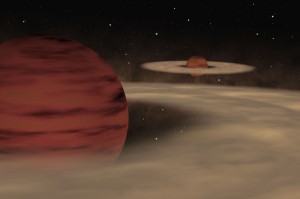
Artist conception of a captured world drifting at the outer edge of a distant star system, so far from its sun-like host the star's disk is barely resolvable at upper right. (Image: Christine Pulliam, Center for Astrophysics)
Like sports teams swapping players, billions of stars within our own galaxy may have traded planets which once wandered freely throughout the galaxy in interstellar space with each other.
Those findings, from a new study, could explain why some planets within a solar system have an orbit far from their host stars. The study’s authors believe it could also explain the existence of double-planet systems – two astronomical objects that can be technically considered planets and are close enough to each other to have a substantial gravitational influence on each other compared to the effect of the star(s) they orbit.
Hagai Perets from the Harvard-Smithsonian Center for Astrophysics and Thijs Kouwenhoven of China’s Peking University authored the study which will be published in an upcoming edition of the Astrophysical Journal.
In many cases, scientists say these rogue planets are created as a byproduct of a star’s formation. Newly-formed solar systems tend to have a number of planets, and if any of these planets interact with each other as they’re finding their place within the star system, one of those planets can be kicked out and becomes a nomad.
If, during its travels, it should happen to come across another star moving in the same direction and at the same speed, the traveling planet could attach itself to that star’s solar system.
However, some of these rogue planets may not be castaways from other solar systems, but instead could have been created independently, similar to how stars are formed. The International Astronomical Union (IAU) calls these particular planetary objects “sub-brown dwarfs.”

Artist's impression of what a rogue double system of planetary objects might look like. While the two planetary objects do not orbit around a star, they do appear to circle each other instead. (Image: ESO)
Rogue planets that become part of another solar system tend to be on the very edge of the solar system, have a unique orbit, and revolve around their adopted star in an opposite direction of the other “native planets.”
Drs. Perets and Kouwenhoven created simulations of young star clusters that also had “free-floating planets.” The researchers determined that if the number of stars and rogue planets were equal, then between three-to-six percent of those stars would nab one of the rogue planets over time. They also noted that, the more massive the star, the more likely it was to grab a wandering planet.
The researchers chose to study young star clusters because they found the seizure of rogue planets is more likely when both the stars and the “free-floating planets” are jammed in a small space.
These star clusters tend to scatter away from each other after a period of time. The scientists figured if any inter-system swapping of planets is to be done, it has to happen early in the cluster’s history.
Astronomers haven’t found any specific cases of captured planets so far.
It could be tough to determine whether they’ve spotted an actual captured rogue planet, or if it is a native planet mimicking the behavior of a rogue planet due to various gravitational interactions within its solar system.





















Traveling the same direction at the same speed is NEVER sufficient to capture a planet without an extremely-fortuitous 3-body interaction, and the typical 3-body interaction would involve a multiple star system. The article makes it sound as though the typical stellar system is like the Brady Bunch which couldn’t be more misleading.